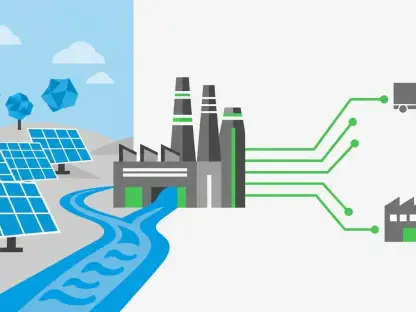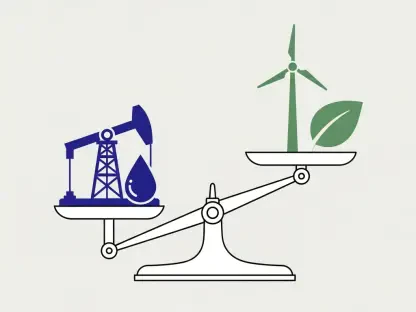Energizing the Digital Boom: Why Data Center Power Needs Are Reshaping Utilities
In an age where digital infrastructure underpins nearly every facet of modern life, the energy appetite of data centers has emerged as a defining challenge for the utility sector, pushing companies to rethink capacity planning. With cloud computing, artificial intelligence, and big data analytics driving unprecedented growth, these facilities are consuming electricity at a staggering rate. PPL Corporation, based in Allentown, Pennsylvania, has stepped into this arena with a bold settlement agreement through its subsidiaries, Louisville Gas and Electric (LG&E) and Kentucky Utilities (KU), to develop 1.3 gigawatts (GW) of gas-fired power generation in Kentucky. This move targets the escalating demands of data centers alongside other industrial loads, spotlighting a critical intersection of technology and energy markets. This analysis delves into the trends fueling this expansion, dissects the strategic components of the plan, and projects its impact on the broader utility landscape.
Market Trends: Decoding the Surge in Data Center Energy Consumption
Exponential Growth in Digital Infrastructure
The utility sector is witnessing a seismic shift as data centers transform from niche consumers to dominant players in energy demand. Industry projections indicate that data center electricity needs could double within the next decade, driven by tech giants expanding their footprint in regions with competitive energy costs and robust grid infrastructure. In Kentucky alone, LG&E and KU anticipate a load increase of 1,875 MW from data centers by 2032, with an additional 580 MW from other commercial and industrial sectors. This trend reflects a national pattern where digital transformation is not just a technological evolution but a fundamental driver of power market dynamics, compelling utilities to prioritize scalable solutions over traditional load planning models.
Utilities at a Crossroads: Balancing Speed and Sustainability
As demand spikes, utilities face mounting pressure to deliver reliable power while navigating the transition to cleaner energy sources. The rapid deployment of data centers often outpaces the development of renewable infrastructure, creating a gap that fossil fuel-based solutions, like natural gas, are positioned to fill in the short term. This tension is evident across the market, with many providers opting for gas-fired plants due to their quicker build times and operational flexibility compared to solar or wind projects. However, this approach sparks debates among stakeholders about long-term environmental impacts, as reliance on gas could delay decarbonization targets, highlighting a critical challenge in aligning immediate market needs with future sustainability goals.
Regional Dynamics and Economic Incentives
Kentucky’s emergence as a hub for data center growth is no accident, fueled by favorable energy pricing and strategic geographic positioning. The state’s relatively low electricity costs, combined with existing utility infrastructure, make it an attractive destination for tech investments, a trend mirrored in other regions like Virginia and Texas. Economic incentives and regulatory support further amplify this appeal, encouraging utilities to expand capacity to capture market share. Yet, this regional boom also introduces risks, such as overbuilding capacity for speculative demand, a concern that shapes the cautious strategies of companies like PPL as they adapt to these localized market forces.
Strategic Analysis: Unpacking PPL’s 1.3 GW Expansion Blueprint
Gas-Fired Capacity as a Near-Term Market Solution
Central to PPL’s strategy is the development of two 645-MW combustion turbine units at existing facilities, scheduled for operation in 2030 and 2031. Positioned at sites like Mill Creek, these gas-fired units address the urgent need for reliable power to support data center expansion, offering a faster-to-market option compared to renewable alternatives. From a market perspective, this move capitalizes on natural gas’s cost-effectiveness and grid stability benefits, positioning PPL to meet immediate load growth while maintaining competitive service offerings. However, this focus on gas also reflects a broader industry trend of using fossil fuels as a bridge, raising questions about how long such strategies will remain viable amid tightening environmental regulations.
Navigating Transition Risks with Coal Retirement Delays
A notable aspect of the settlement is the postponed retirement of the 297-MW coal-fired Mill Creek 2 unit, now extended until the new gas-fired Mill Creek 6 unit is operational in 2031, with potential for further evaluation beyond that date. This decision underscores a market-driven pragmatism, ensuring grid reliability during a period of rapid capacity addition. While this delays the phase-out of high-emission coal, it mirrors a wider utility trend of staggered transitions to avoid supply disruptions, especially in regions with significant industrial growth. The approach highlights the delicate balance between maintaining market confidence in energy supply and responding to pressures for cleaner energy portfolios.
Renewable Integration and Market Accountability Measures
Beyond fossil fuels, PPL’s plan embeds a forward-looking commitment to renewables, with LG&E and KU set to issue a request for proposals for renewable energy and storage by mid-2026, targeting regulatory approval by late 2028. Additionally, annual reports on participation in the Southeast Energy Exchange Market and semi-annual updates on construction and load forecasts signal a push for transparency, addressing market concerns about speculative overbuild. These steps align with an industry shift toward hybrid energy models, where utilities are increasingly evaluated on their ability to diversify supply while managing costs. This strategic focus on accountability could set a precedent for how utilities mitigate financial risks in volatile demand environments.
Future Projections: The Evolving Landscape of Utility Markets
Data Centers as Catalysts for Grid Innovation
Looking ahead, the relentless growth of data centers is poised to redefine utility market structures, driving innovation in grid planning and energy delivery. Forecasts suggest that by 2030, data centers could account for a significant portion of new load growth in key regions, prompting investments in advanced storage solutions and smart grid technologies. PPL’s hinted $20 billion capital plan through 2028, with potential transmission upgrades in areas like Pennsylvania, reflects this market evolution, positioning the company to support tech-driven demand beyond Kentucky. The trajectory indicates a future where utilities must prioritize flexibility to adapt to fluctuating load profiles and emerging tech hubs.
Regulatory and Economic Implications on Market Strategies
The regulatory environment will play a pivotal role in shaping utility responses to data center demand, with states likely to impose stricter guidelines on cost recovery and environmental compliance. PPL’s agreement includes safeguards, such as securing at least 500 MW of executed high load factor agreements before passing costs to ratepayers for Mill Creek 6, illustrating a market trend toward shared financial responsibility. Economically, the influx of tech investments could boost regional markets, but it also raises the stakes for utilities to avoid stranded assets if demand projections falter. This dynamic suggests a future where regulatory foresight and economic alignment will be as critical as capacity expansion.
Hybrid Energy Models as the Market Standard
Industry analysis points to hybrid energy systems—combining gas, renewables, and storage—as the likely standard for utilities over the next decade. PPL’s dual focus on gas-fired units and renewable procurement mirrors this market shift, offering a blueprint for balancing short-term reliability with long-term sustainability. As storage technology costs decline and renewable integration accelerates, utilities may pivot more aggressively toward cleaner solutions, reducing dependence on gas. This projection underscores a transformative period for the market, where adaptability and strategic diversification will determine competitive advantage in meeting digital infrastructure needs.
Reflecting on the Market Insights: Strategic Pathways Forward
Reflecting on this analysis, PPL Utilities’ 1.3 GW gas-fired expansion emerges as a calculated response to the burgeoning energy demands of data centers, capturing a pivotal moment in utility market evolution. The blend of immediate gas capacity, delayed coal retirements, and renewable commitments illustrates a nuanced strategy to navigate market pressures while ensuring grid stability. For stakeholders, the takeaway is clear: collaboration between utilities and tech industries becomes essential to align energy planning with actual demand, potentially through innovative rate structures. Looking back, the emphasis on transparency and regulatory oversight offers a model for mitigating financial risks, while the push for hybrid energy solutions lays groundwork for sustainable growth. As markets move forward, the challenge remains to accelerate renewable adoption and invest in grid modernization, ensuring that the digital age is powered by resilience and foresight.









